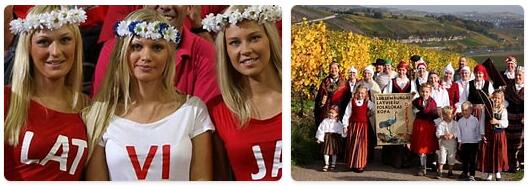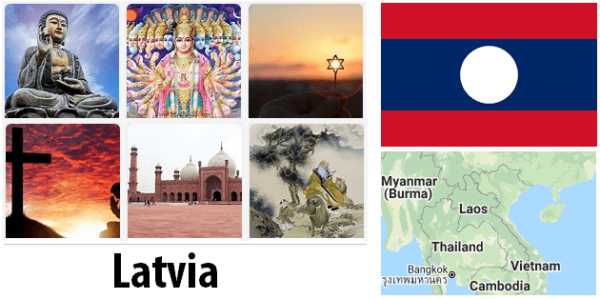The first residents of present-day Latvia were nomadic tribes of hunters, fishermen and collectors who emigrated to the forests of the Baltic coast after the glaciers had retreated after the last ice age. Around the year 2,000 BCE, these peoples were displaced by the Baltic peoples who were Indo-European tribes developing agriculture and permanently settled in Latvia, Lithaun and eastern Prussia.
The Letters are one of the most important branches of the ancient group of Baltic people who were in contact with the Roman Empire through their amber trade. This trade peaked during the first centuries of our era, and was only interrupted by the Slavs’ expansion into Central and Eastern Europe. The trade and cultural relations of the Baltic people were now oriented instead to their Scandinavian neighbors.
The Danes’ expansion towards the steppes north of the Black Sea occurred through the rivers Dvina and Dnieper and through Latvian territory. In the 10th and 11th centuries, Swedes and Russians fought over this area, and in the 12th century German warriors and missionaries arrived on the Latvian coast inhabited by the Livos, which is why the Germans called the area Livonia. In 1202, the bishop of the region – with the permission of Rome – founded the Sword Order (see Estonia).

Before the order in 1237 was converted to the order of the Teutons, the Germans had subordinated themselves and Christianized the Latvian and Estonian tribes. The Teutons formed the so-called Livonia Confederation, which consisted of church states, free cities and areas ruled by fighters. In the middle of the 16th century, the rivalry within Livonia increased by the expansion of Protestantism and the dissatisfaction of the peasants.
During the same period, the reliefs benefited from Riga’s participation in the Hansa federation – the German trade cooperation that created extensive prosperity. Still, Livonia was treated by the Germans like any other forced nation. The native nobility was eliminated and the peasants forced to pay taxes – i.e. through work.
When Russia invaded the region in 1558 to curb the Polish-Lithuanian expansion, the order fell apart and Livonia was divided. At the end of the Livonia War in 1583, Lithaun annexed the area north of the Dvina River, Poland got the southern part, while Sweden occupied the northern part of Estonia. In 1621 Sweden occupied Riga and Jelgava. With the Altmark ceasefire of 1629, the Swedes gained control of Estonia and the northern part of Latvia.
Political development in the 1990s
During the parliamentary elections in the fall of 1995, the party picture was unclear: several new parties emerged, others changed their names or disappeared. The main trend was to populist. Parties on the outer wings received increased support, while the center parties were weakened. The country’s difficult economic situation, rapidly increasing social differences, crime and corruption were the backdrop for the polarization and political skepticism among the electorate. The Latvian government’s path declined sharply, while the center-left party Democratic Party Saimnieks (DPS) became the largest. After lengthy government negotiations, a broad coalition government was formed. Businessman Andris Šķēle became prime minister. He had a background in DPS, but was now party-political independent. Šķēle had to step down in 1997 due to a series of corruption scandals, but the same coalition continued in government. Guntars Krasts from the Fatherland Party became new prime minister.
The 1998 elections brought about major changes in the National Assembly; both the DPS and the right-wing populist party lost all their seats. A new center party – the People’s Party (TP), founded by former Prime Minister Šķēle – received the largest support with 24 seats. But the party was kept out of government offices. However, a new government crisis in the summer of 1999 led the Fatherland Party to enter into a cooperation agreement with the People’s Party, and Šķēle became prime minister again.
Political development in the 2000s
In 1999, President Ulmanis resigned and was succeeded by Vaira Vike-Freiberga. She became the first female president in Central and Eastern Europe and was re-elected by a clear margin in 2003.
One month after the inauguration, President Vike-Freiberga refused to sign a new language law passed by the National Assembly. It would make it more difficult to use Russian in a variety of contexts. But the new president believed it was in violation of freedom of speech and information and was supported by the EU, among others. Nonetheless, linguistic demands were placed on candidates running for parliamentary elections. The language requirements were removed from the Election Act in 2002.
In April 2000, Šķēle resigned as prime minister to avoid being fielded in a vote of confidence. The background was a dispute over privatization within the government, which had fielded two governments after the 1998 elections. This disagreement created major problems between the Liberal People’s Party and the Nationalist Fatherland Party. Andris Berzins took over as prime minister for a new coalition government the following month, but he had to step down after the election in 2002. Then another new party became the largest; center – right party New Era (26 out of 100 seats). The former Governor of the Central Bank and founder of the New Era, Einars Repše, became prime minister of a four-party government. The election result was interpreted as a settlement with the corruption and public mismanagement that has characterized Latvia since independence. But this government also disintegrated.
In 2008, Valdis Zatlers was elected president. The previous president, Vaira Vike-Freiberga, was throughout his time as president of Latvia’s most popular politician. The president of Latvia has limited power, but often acts as a representative figure and advocate.
Prime Minister Godmanis and his coalition government took over in 2007 after the Kalvitis government, but with the same coalition structure. According to thesciencetutor, the main priority of the Latvian government has been and is economic growth to reach the EU’s average income level as quickly as possible. The country faces major challenges in relation to inflation, the budget deficit and the labor market.
